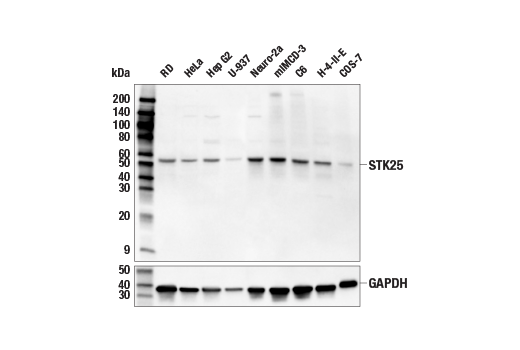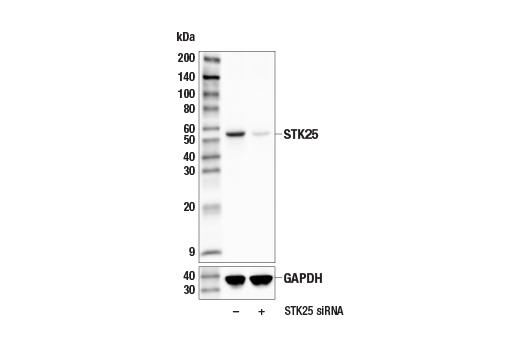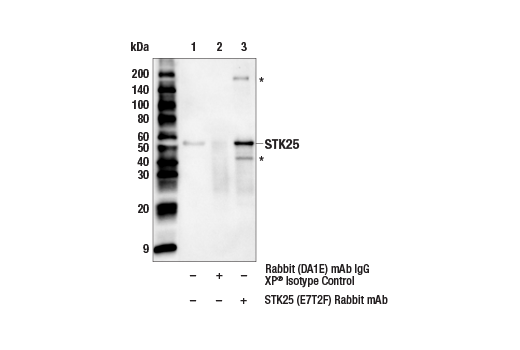WB, IP
H M R Mk
Endogenous
55
Rabbit IgG
#O00506
10494
Product Information
Product Usage Information
| Application | Dilution |
|---|---|
| Western Blotting | 1:1000 |
| Immunoprecipitation | 1:100 |
Storage
Specificity / Sensitivity
Species Reactivity:
Human, Mouse, Rat, Monkey
Source / Purification
Monoclonal antibody is produced by immunizing animals with a synthetic peptide corresponding to residues surrounding Pro329 of human STK25 protein.
Background
STK25 (Serine/threonine protein kinase 25, YSK, SOK1) belongs to the germinal center kinase III (GCKII) subfamily of sterile-20 (STE20) protein kinases (1). STK25 is highly conserved across metazoans, and is reported to be involved in various core cellular processes, including cell migration (2,3) and metabolism (4,5). Along with the closely related MST3 and MST4 kinases, STK25 has been identified as a component of the striatin-interacting phosphatase and kinase (STRIPAK) complex (6). Its role in this regard is one of the mechanisms by which it has been reported to regulate the Hippo signaling pathway (7,8). A defined role for STK25 in lipid metabolism (9) has led some to consider targeting STK25 for the treatment of lipid-related metabolic diseases (10), including non-alcoholic fatty liver disease (NAFLD) and non-alcoholic steatohepatitis (NASH) (11,12).
- Osada, S. et al. (1997) Oncogene 14, 2047-57.
- Matsuki, T. et al. (2021) J Neurosci 41, 8887-8903.
- Preisinger, C. et al. (2004) J Cell Biol 164, 1009-20.
- Kurhe, Y. et al. (2021) Cell Mol Gastroenterol Hepatol 13, 405-423.
- Zhang, Y. et al. (2022) Cancer Cell Int 22, 4.
- Kean, M.J. et al. (2011) J Biol Chem 286, 25065-75.
- Bae, S.J. et al. (2020) Elife 9, e54863. doi: 10.7554/eLife.54863.
- Lim, S. et al. (2019) Nat Commun 10, 1547.
- Nerstedt, A. et al. (2020) J Lipid Res 61, 178-191.
- Cansby, E. et al. (2020) JCI Insight 5, e140483. doi: 10.1172/jci.insight.140483.
- Kühnel, F. (2021) Cell Mol Gastroenterol Hepatol 13, 676-677.
- Cansby, E. et al. (2019) Cell Mol Gastroenterol Hepatol 7, 597-618.
Species Reactivity
Species reactivity is determined by testing in at least one approved application (e.g., western blot).
Western Blot Buffer
IMPORTANT: For western blots, incubate membrane with diluted primary antibody in 5% w/v nonfat dry milk, 1X TBS, 0.1% Tween® 20 at 4°C with gentle shaking, overnight.
Applications Key
WB: Western Blotting IP: Immunoprecipitation
Cross-Reactivity Key
H: human M: mouse R: rat Hm: hamster Mk: monkey Vir: virus Mi: mink C: chicken Dm: D. melanogaster X: Xenopus Z: zebrafish B: bovine Dg: dog Pg: pig Sc: S. cerevisiae Ce: C. elegans Hr: horse GP: Guinea Pig Rab: rabbit All: all species expected
Trademarks and Patents
Limited Uses
Except as otherwise expressly agreed in a writing signed by a legally authorized representative of CST, the following terms apply to Products provided by CST, its affiliates or its distributors. Any Customer's terms and conditions that are in addition to, or different from, those contained herein, unless separately accepted in writing by a legally authorized representative of CST, are rejected and are of no force or effect.
Products are labeled with For Research Use Only or a similar labeling statement and have not been approved, cleared, or licensed by the FDA or other regulatory foreign or domestic entity, for any purpose. Customer shall not use any Product for any diagnostic or therapeutic purpose, or otherwise in any manner that conflicts with its labeling statement. Products sold or licensed by CST are provided for Customer as the end-user and solely for research and development uses. Any use of Product for diagnostic, prophylactic or therapeutic purposes, or any purchase of Product for resale (alone or as a component) or other commercial purpose, requires a separate license from CST. Customer shall (a) not sell, license, loan, donate or otherwise transfer or make available any Product to any third party, whether alone or in combination with other materials, or use the Products to manufacture any commercial products, (b) not copy, modify, reverse engineer, decompile, disassemble or otherwise attempt to discover the underlying structure or technology of the Products, or use the Products for the purpose of developing any products or services that would compete with CST products or services, (c) not alter or remove from the Products any trademarks, trade names, logos, patent or copyright notices or markings, (d) use the Products solely in accordance with CST Product Terms of Sale and any applicable documentation, and (e) comply with any license, terms of service or similar agreement with respect to any third party products or services used by Customer in connection with the Products.


